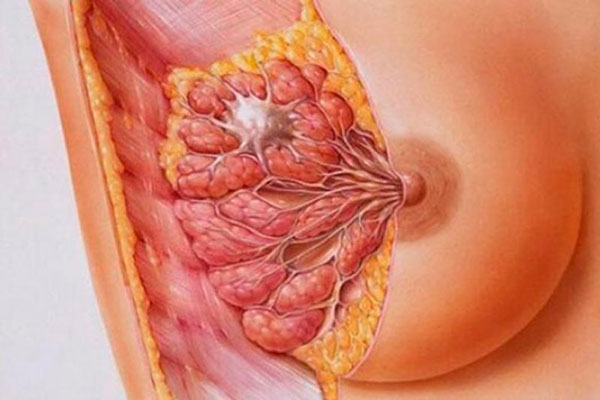Benign Diseases of the Breast
Meme hastalıklarının %70’ini oluştururlar. Malignite(kanser) riski taşımazlar. Ancak, kanser ile karışabilecekleri unutulmamalıdır.
Fibrocystic Changes
It is the most common lesion of the breast.2 It is common in premenopausal women aged 0-50 years. The diagnosis is of little importance as long as malignancy is ruled out. It does not carry a risk for breast cancer unless epithelial proliferative changes with or without atypia are present.
It may be seen as mass lesions without complaints or may cause pain, tenderness and nipple discharge. In premenopausal women, unilateral or bilateral, spontaneous nipple discharge involving more than one duct is usually caused by fibrocystic changes.
On ultrasonography, cysts are divided into 3 groups as simple, complicated and complex.
Complex cysts have both solid and cystic components. The rate of malignancy is % 23-31 and the definite diagnosis is made by biopsy.
Treatment:
It does not require additional treatment except for a good clinical examination and appropriate imaging for age and symptoms.
Providing mechanical support can reduce breast pain.
Physical activity should be increased.
A fat-poor diet and methylxanthine reduction are reported to reduce breast pain.
Evening primrose oil has been found effective in patients with cyclic pain.
Inflammatory Diseases of the Breast
In general, mastitis involves inflammation (inflammatory reaction) of the breast tissue with or without infection. Although mastitis does not increase the risk of cancer, it can be confused with inflammatory breast cancer.
Acute infectious mastitis may be caused by a cyst or enlarged duct in the breast tissue or by infected breast skin. In addition to antibiotics and drainage of the abscess, a biopsy should be performed to exclude cancer. Surgery is recommended in patients with recurrence or fistulisation. In unresponsive cases, it may be necessary to remove all ducts or even the nipple.
Puerperal mastitis is usually common in the first 6 weeks after birth. Mistakes in breastfeeding technique are blamed. Patients present with complaints of tenderness, redness, fever, weakness, body pain. In severe cases, 14 days of antibiotic treatment may be required. Breastfeeding does not need to be stopped. The only non-drug treatment option with evidence value is vitamin E intake.
Delay in treatment or inadequate treatment causes recurrent mastitis. In case of recurrent infection, breastfeeding on that side should be stopped. If abscess is suspected, USG should be performed. Surgical drainage and antibiotic treatment is required.
Granulomatous mastitis is a condition characterised by granulomatous inflammatory reaction of the breast and clinically and radiologically resembles breast cancer. It is mostly seen in premenopausal patients. Both breasts are equally involved. The mass may sometimes form a fistula; however, unlike abscesses, it does not cause systemic findings. The only recognised treatment is surgery and steroid therapy. In the presence of abscess, drainage and antibiotic treatment is required.
Ductal Ectasia
It is seen in women aged 50-60 years and those who have had many births. It may present as a mass around the nipple, shrinkage of the skin, pain unrelated to menstruation, cheesy discharge from the nipple, dilated ducts with the appearance of thick copper wire extending radially towards the nipple, or it may not present any symptoms.
Fibroadenoma
Fibrokistik hastalıktan sonra en sık görülen benign meme hastalığıdır. 30-35 yaş altı kadınlarda en sık rastlanan meme kitleleridir.Olguların %10-20’si multipldir(çok sayıda). Bilateral(iki taraflı) olabilir.
They usually appear as well-circumscribed, mobile and rubbery masses up to 2 cm in size. Since they are under the influence of hormones, they regress after menopause. Simple fibroadenomas are not associated with cancer. Annual follow-up is recommended every 6 months in the first year and every 3 years thereafter. Biopsy is recommended in cases with growing masses or suspicion of cancer.
Complex fibroadenoma is considered to have a minimal increase in the risk of breast cancer.
Intraductal Papilloma
Memenin papiller lezyonları birçok alt türlere ayrılır. Iyi huylu papillomlarda şikayet genellikle meme başı akıntısıdır. Daha sıklıkla 40-55 yaş arasında görülürler. Papilomatozis(çok sayıda olması) daha genç yaşta, ancak daha nadir görülen bir alt tipi olup, kanser gelişim riski daha yüksektir. Jüvenil papillomatozis ise 20-30 yaş hastalarda kitleler şeklinde kliniğe yansır.Olguların %25-58’inde ailede meme kanseri vardır.
Galactography and ultrasonography give valuable findings. MR galactography is costly but superior to other imaging modalities. Ductoscopy is the most important recent development but its use is limited due to its high cost.




Comment: